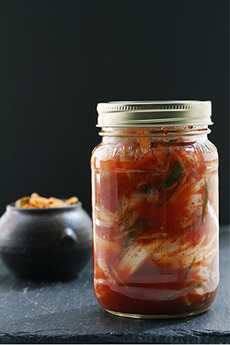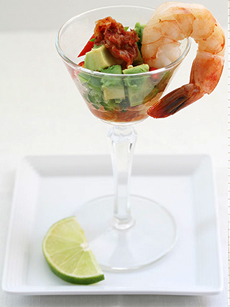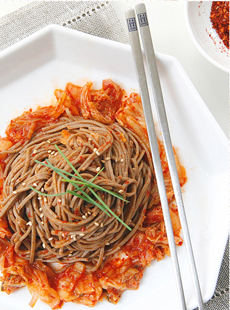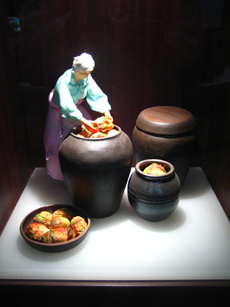
 Healthy cabbage and other vegetables are fermented—like sauerkraut, but with a unique Korean flavor. Photo by Jessica Boucher | Mother In Law’s Kimchi. Healthy cabbage and other vegetables are fermented—like sauerkraut, but with a unique Korean flavor. Photo by Jessica Boucher | Mother In Law’s Kimchi.
|
KAREN HOCHMAN is Editorial Director of THE NIBBLE.
|
|
August 2010
|
 |
Mother In Law’s Kimchi
A Healthy, Probiotic Food Takes On New Life As
Gourmet Artisan Pickles
CAPSULE REPORT: Kimchi are pickles that are pungent and fiery, seasoned with red chile flakes (or in the case of this fine artisan product, whole chiles). Considered the national dish of Korea by many, kimchi is eaten as a side dish as well as incorporated into recipes. It’s a terrific fusion food, pairing well with everything from eggs to sandwiches to meat to tacos. This is Page 1 of a two-page article. Click on the black links below to visit other pages.
Kimchi History
Kimchi is a traditional Korean dish, the most common side dish in Korean cuisine. It is also a main ingredient in many popular Korean dishes, such as kimchi stew. Born of an agrarian society, kimchi was made year-round, but in larger quantities during the winter months, when fresh vegetables were few. Like many societies pre-refrigeration, pickled vegetables were a winter mainstay.
Most recipes—the Kimchi Field Museum in Seoul has documented 187 historic and current varieties—are made of fermented vegetables. While Chinese (napa) cabbage is the most popular variety, there are many regional and seasonal recipes. A broad selection of vegetables are used, including cucumber, perilla (shiso), radish (daikon) and scallion. The seasonings include brine, chile flakes, fish sauce, ginger, garlic and spices, depending on the type of kimchi being made.
It is also spelled kimchee, kim chee or gimchi. The name derives from chimchae, soaked vegetables.
Kimchi may date as far back as 1000 B.C.E.
- Early versions of kimchi were made with cabbage and beef stock.
|
|

A fusion shrimp cocktail garnished with kimchi. Photo by Jessica Boucher. |
- The twelfth century saw an expansion of the varieties of kimchi, using different spices to create sweet and sour kimchi and recipes with a broader variety of vegetables.
- Regional styles evolved. The warmer southern regions used more anchovy sauce as a preservative. In northern regions, the less pungent shrimp sauce became popular.
- Red chile flakes, the main spice in many varieties of kimchi, were added after the fruit (yes, chiles are fruits) arrived in Korea from the New World around 1500.
The vegetables and spices were made in large earthenware jars, then buried in the ground to protect and preserve them as they fermented.
Today, kimchi is a fusion food. You can add it to a Blood Mary, bake a kimchi frittata, add it to a shrimp and avocado cocktail, make a Korean-style pork taco, serve it with cold sesame soba noodles and make bacon and sausage kimchi hors d’oeuvre on rice crackers. It can be served alongside pork chops, ramen, scrambled eggs, steak tacos and stew. Try it with sandwiches. These are pickles: Use them as you would American pickles.
|
|

Cold sesame soba noodles with kimchi. Photo by Jessica Boucher. |
Like that other famous fermented cabbage dish, sauerkraut, kimchi is a probiotic food: Spicy as it seems, it helps with digestion. (Learn more about probiotic food.)
How Kimchi Is Made
You need vegetables and brine to start.
- The initial fermentation of vegetables occurs after one or two days at room temperature. The fermenting vegetables release carbon dioxide; then the juices start to bubble.
- The brine becomes tangy and acidic and the vegetables mellow and ripen.
- Kimchi continually ferments and ripens as it ages. It never goes bad and the vegetables remain crunchy. Don’t worry about bubbles in your jar of kimchi—that’s the ongoing fermentation.
Continue To Next Page: Varieties Of Kimchi
Go To The Article Index Above
|
|

From the Kimchi Field Museum in Seoul, Korea, this statue shows a woman making kimchi from heads of cabbage. Photo by Ayustety | Wikimedia. |
|







